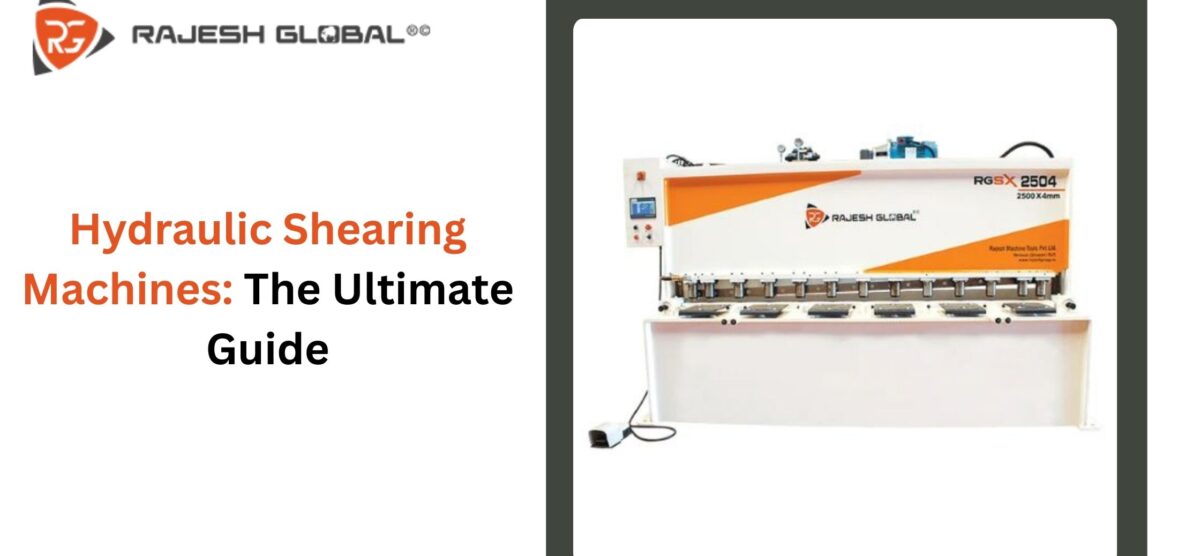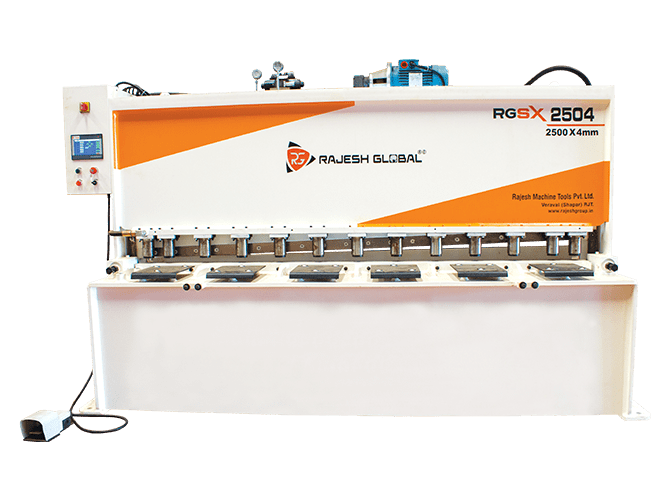Blog

Hydraulic Shearing Machines: The Ultimate Guide
Hydraulic shearing machines have redefined efficiency, precision, and productivity in the world of metal fabrication. As industries scale up to meet growing demands, the choice of the right shearing technology becomes critical. This guide by Rajesh Machine Tools demystifies hydraulic shearing machines, exploring their engineering, applications, maintenance, and the latest advancements driving the future of metal cutting.
What is a Hydraulic Shearing Machine?
Contents
- 1 What is a Hydraulic Shearing Machine?
- 2 Key Components of a Hydraulic Shearing Machine
- 3 How Hydraulic Shearing Machines Work?
- 4 Types of Hydraulic Shearing Machines
- 5 Features That Set Hydraulic Shearing Machines Apart
- 6 Applications Across Industries
- 7 Advantages of Hydraulic Shearing Machines
- 8 Technological Innovations and Industry Trends
- 9 Maintenance: Maximizing Machine Life and Performance
- 10 Safety Considerations
- 11 Choosing the Right Hydraulic Shearing Machine
- 12 Market Outlook and Future Growth
- 13 Why Rajesh Machine Tools Sets the Benchmark?
- 14 Conclusion
A hydraulic shearing machine is an industrial tool designed for cutting sheet metal and plates with high precision and speed. By harnessing hydraulic power, these machines ensure cleaner cuts, safer operations, and improved efficiency compared to traditional mechanical shears. The key distinction lies in the use of hydraulic cylinders, which provide the downward force necessary to shear materials with consistent accuracy.
Key Components of a Hydraulic Shearing Machine
Understanding the anatomy of a hydraulic shearing machine helps optimize its operation:
- Frame and Structure: Heavy-duty welded steel frames provide maximum rigidity, minimize vibration, and enhance durability.
- Hydraulic System: The main powerhouse, responsible for generating shearing force. Key parts include hydraulic pumps, cylinders, and high-pressure lines.
- Shearing Blades: Hardened, high-carbon steel blades for precise and clean cuts. Quick-change mechanisms enhance efficiency.
- Backgauge System: Allows precise positioning of material, essential for repeatability.
- Hold-Down Clamps: Secure the sheet in place before and during cutting.
- Control Panel: Modern machines feature NC/CNC systems for programming, digital displays, and user-friendly operation.
- Safety Features: Light gates, emergency stops, guarding, and sensors to protect operators and equipment.
How Hydraulic Shearing Machines Work?
The basic working principle involves:
- The material is positioned against the backgauge and secured with hold-down clamps.
- Hydraulic cylinders power the blade beam to descend, shearing the metal sheet.
- Adjustable rake angles and blade clearances allow the machine to handle different material thicknesses and qualities for optimized cuts.
- Post-cut, the beam is returned to its initial position, ready for the next cycle.
The seamless coordination between hydraulic and control systems ensures consistent force and clean, distortion-free results.
Types of Hydraulic Shearing Machines
Different machine configurations serve varied industry needs:
- Guillotine Hydraulic Shears: Vertical cutting motion; ideal for straight, precision cuts on thick materials.
- Swing Beam Hydraulic Shears: Pivoting upper beam; typically used for high-speed production of lighter-gauge sheets.
- NC Hydraulic Shears: Semi-automatic, suitable for variable production volumes.
- CNC Hydraulic Shears: Fully programmable, enabling mass production with minimal manual intervention.
Features That Set Hydraulic Shearing Machines Apart
Modern hydraulic shearing machines deliver a competitive edge with features like:
- Variable rake angle and rapid blade gap adjustment for handling diverse materials.
- Front operated power backgauge, facilitating accurate and swift setup for repeat jobs.
- Hydraulic hold-downs to prevent sheet slippage.
- Digital displays and programmable logic controls (PLC/CNC) for automation.
- Safety guards, light curtains, and overload interlocks for enhanced operator safety.
- Low noise operation and energy-efficient hydraulic packs for sustainability.
Applications Across Industries
Hydraulic shearing machines are indispensable in:
- Metal Fabrication Workshops: Cutting sheets and plates for construction, machinery, and structural components.
- Automotive: Manufacturing body panels, chassis, and engine parts.
- Shipbuilding: Processing large steel plates for hulls and bulkheads.
- Aerospace: Producing precision parts from aluminum and advanced alloys.
- Appliances & Electrical: Forming enclosures, cabinets, and frames.
- Infrastructure: Manufacturing beams and supports for bridges and buildings.
Advantages of Hydraulic Shearing Machines
- Superior Precision: Adjustable blade clearance and hydraulic synchronization ensure clean, burr-free edges and minimal material distortion.
- High Productivity: Capable of rapid, repetitive cuts with minimal operator fatigue.
- Versatility: Can process steel, aluminum, brass, and more, across various thicknesses with easy adjustments.
- Cost-Effectiveness: Reduces waste and lowers labor costs through automation and efficient material utilization.
- Enhanced Safety: Built-in interlocks, guards, and safety sensors reduce accident risks, making modern hydraulic shears safer than mechanical alternatives.
- Reduced Maintenance: Fewer moving parts and robust construction translate to lower maintenance needs and longer life spans.
Technological Innovations and Industry Trends
The future of hydraulic shearing is defined by integration and intelligence:
- Smart CNC Control Systems: Automation, pattern storage, real-time monitoring, and easy program changes reduce downtime and boost efficiency.
- IoT and AI: Real-time data collection allows predictive maintenance, optimizing performance and preventing unexpected breakdowns.
- Energy Efficiency: Servo-hydraulic and variable-speed pumps reduce energy consumption, supporting sustainability goals.
- Adaptive Systems: Sensors and AI algorithms enable automatic adjustments for material types, thickness, and cutting speed, improving accuracy and reducing waste.
- Eco-Friendly Solutions: Adoption of recyclable components, biodegradable hydraulic fluids, and sustainable design practices align with global trends.
Maintenance: Maximizing Machine Life and Performance
Regular maintenance is essential:
| Task | Frequency |
| Lubricate moving parts | Daily/Weekly |
| Inspect blade sharpness | Weekly |
| Check hydraulic oil (level, quality, leaks) | Monthly |
| Clean machine and work area | Daily |
| Inspect safety devices | Monthly |
| Replace hydraulic oil/filter | Annually |
Best practices:
- Lubrication: Follow manufacturer charts for all moving components.
- Blade Care: Keep blades sharp and replace them when worn to maintain cut quality.
- Hydraulic System: Monitor for leaks, replace oil and filters on schedule, and inspect hoses periodically.
- Electrical System: Check wiring, switches, and panel cleanliness routinely.
- Operator Training: Ensure only trained personnel operate the machine, understand emergency procedures, and stay updated on maintenance protocols.
Safety Considerations
Operator safety is non-negotiable. Key practices include:
- Never bypass safety guards or interlocks.
- Always wear appropriate PPE.
- Use only certified operators.
- Keep hands and objects clear of the cutting area.
- Regularly inspect and maintain safety systems, including emergency stops, light curtains, and interlocks.
Choosing the Right Hydraulic Shearing Machine
To select the ideal machine:
- Define Production Volume: Consider required cutting thickness, material type, and sheet dimensions.
- Prioritize Key Features: Look for automation, digital controls, and robust safety mechanisms.
- Evaluate Support: Assess after-sales service, spare parts availability, and supplier reputation.
- Consider Future-Proofing: Choose machines equipped with smart features, IoT readiness, and energy-efficient technologies.
Market Outlook and Future Growth
The global hydraulic shearing machine market is poised for significant growth. Valued at over $5.8 billion in 2023, the market is expected to reach nearly $9.5 billion by 2031 with a CAGR of 5.5%. Drivers include accelerating industrialization, increased demand for high-precision fabrication, and rapid adoption of automation in emerging markets.
Why Rajesh Machine Tools Sets the Benchmark?
Rajesh Machine Tools leads the way with:
- Decades of expertise and in-house R&D.
- Custom-engineered machines for diverse applications, from small workshops to large industrial plants.
- Integration of cutting-edge controls, smart diagnostics, and eco-friendly designs.
- Nationwide service, robust after-sales support, and a client-centric approach.
Conclusion
Hydraulic shearing machines are the unsung heroes of modern manufacturing—powerful, precise, and increasingly intelligent. By understanding their capabilities, applications, maintenance, and the latest industry innovations, businesses can unlock greater efficiency, safety, and profitability. When you invest in a hydraulic shearing machine from Rajesh Machine Tools, you’re not just purchasing equipment—you’re securing the future of your metal fabrication operations.






